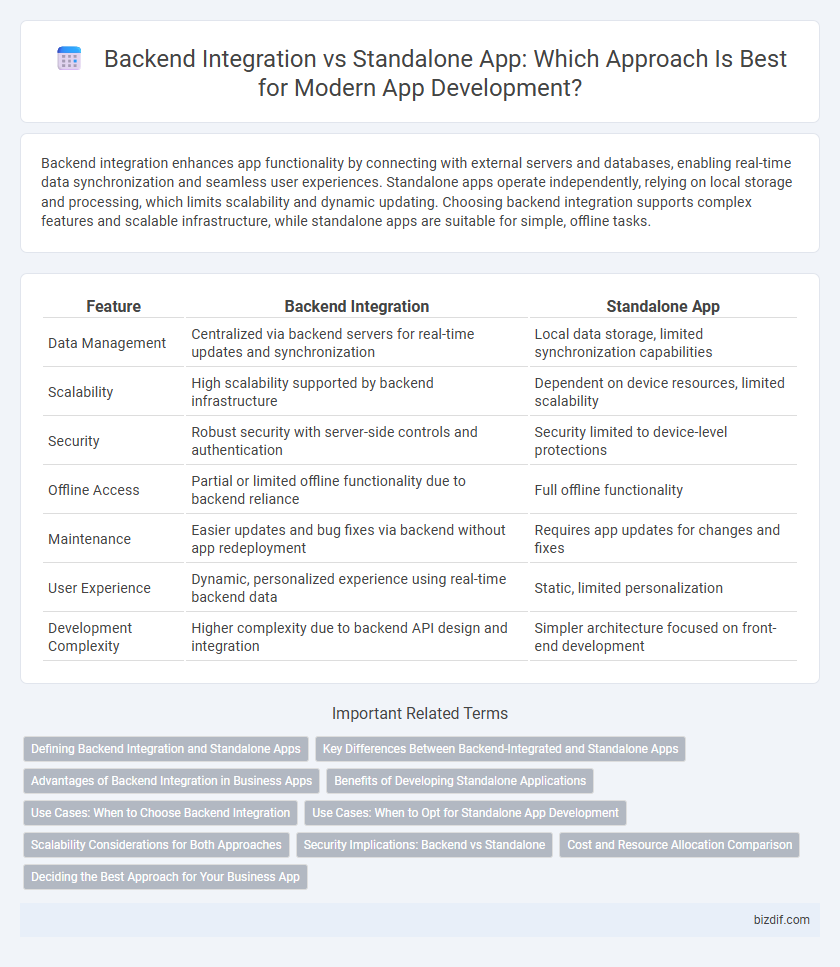Backend integration enhances app functionality by connecting with external servers and databases, enabling real-time data synchronization and seamless user experiences. Standalone apps operate independently, relying on local storage and processing, which limits scalability and dynamic updating. Choosing backend integration supports complex features and scalable infrastructure, while standalone apps are suitable for simple, offline tasks.
Table of Comparison
| Feature | Backend Integration | Standalone App |
|---|---|---|
| Data Management | Centralized via backend servers for real-time updates and synchronization | Local data storage, limited synchronization capabilities |
| Scalability | High scalability supported by backend infrastructure | Dependent on device resources, limited scalability |
| Security | Robust security with server-side controls and authentication | Security limited to device-level protections |
| Offline Access | Partial or limited offline functionality due to backend reliance | Full offline functionality |
| Maintenance | Easier updates and bug fixes via backend without app redeployment | Requires app updates for changes and fixes |
| User Experience | Dynamic, personalized experience using real-time backend data | Static, limited personalization |
| Development Complexity | Higher complexity due to backend API design and integration | Simpler architecture focused on front-end development |
Defining Backend Integration and Standalone Apps
Backend integration involves connecting an app to external servers or databases to enable real-time data exchange, processing, and storage, enhancing functionality and scalability. Standalone apps operate independently on the user's device without requiring continuous communication with remote servers, offering faster performance and offline usability. Choosing between backend integration and standalone architecture impacts app security, user experience, and maintenance complexity.
Key Differences Between Backend-Integrated and Standalone Apps
Backend-integrated apps rely on server-side databases and APIs to manage dynamic content, enabling real-time data synchronization and multi-user collaboration. Standalone apps operate independently on a device without internet connectivity, offering faster performance and enhanced privacy but limited data sharing capabilities. The choice impacts scalability, data management, and user experience based on project requirements.
Advantages of Backend Integration in Business Apps
Backend integration in business apps enhances real-time data synchronization, ensuring seamless communication between front-end interfaces and databases. This integration supports scalable architecture, enabling efficient handling of complex business logic and multi-user environments. It also improves security by centralizing data management and access control, reducing vulnerability risks in standalone applications.
Benefits of Developing Standalone Applications
Developing standalone applications eliminates dependency on external servers, enhancing app reliability and performance with faster response times. Standalone apps improve user privacy by storing data locally, reducing security risks associated with backend data transmission. These apps also simplify deployment and maintenance processes, as they require fewer backend resources and reduce potential points of failure.
Use Cases: When to Choose Backend Integration
Backend integration is ideal for apps requiring dynamic data synchronization, real-time updates, and centralized user management, such as e-commerce platforms, social media apps, and enterprise solutions. It enables seamless communication between the app and server-side databases or APIs, ensuring consistent and personalized user experiences across devices. Standalone apps suit simpler use cases with limited or no dependency on external data, while backend-integrated apps are essential for scalability and complex business logic.
Use Cases: When to Opt for Standalone App Development
Standalone app development is ideal for use cases requiring offline functionality, enhanced security, or simplicity without relying on continuous backend connectivity. Mobile games, utilities like calculators or note-taking apps, and certain data-sensitive applications benefit from this approach by minimizing dependency on external servers. This method reduces complexity and can improve performance when real-time data synchronization is unnecessary.
Scalability Considerations for Both Approaches
Backend integration enhances scalability by enabling distributed processing, cloud resources, and database management to handle growing user demand efficiently. Standalone apps face limitations in scaling due to local device constraints, requiring frequent updates and optimizations to maintain performance under increased load. Choosing backend integration supports seamless scalability through modular architecture and resource allocation tailored to evolving application needs.
Security Implications: Backend vs Standalone
Backend integration offers enhanced security by centralizing data processing and storage, allowing for robust access controls, encryption, and real-time monitoring. Standalone apps often store sensitive data locally, increasing risks of unauthorized access and data breaches due to less stringent security measures. Implementing backend integration reduces exposure to vulnerabilities by isolating critical functions from the client-side environment.
Cost and Resource Allocation Comparison
Backend integration typically demands higher upfront costs and resource allocation due to server setup, API development, and ongoing maintenance, whereas standalone apps often require less infrastructure investment but may face limitations in scalability and feature expansion. Allocating resources for backend integration involves cross-functional teams including backend developers, database administrators, and security experts, while standalone app development usually centers on front-end and local data management specialists. Cost efficiency depends on project scope and long-term goals; integrated backend systems offer better support for growth and complex functionalities despite initial higher expenses.
Deciding the Best Approach for Your Business App
Choosing between backend integration and a standalone app depends on the business requirements for data synchronization, scalability, and user experience. Backend integration enables real-time data updates, centralized management, and seamless interaction with other enterprise systems, making it ideal for apps requiring complex workflows. Standalone apps operate independently, offering faster deployment and offline capabilities but may face challenges in data consistency and long-term maintenance.
Backend Integration vs Standalone App Infographic

 bizdif.com
bizdif.com